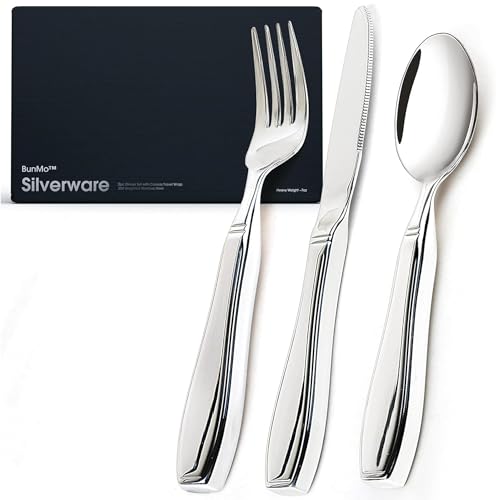
Eating is a daily activity that most people take for granted. Yet, for those with mobility issues, tremors or muscle weakness, mealtime can become a daunting task. Adaptive silverware is designed to assist those with limited hand dexterity. This enables them to regain their independence and enjoy eating again.
In this guide we are primarily going to explore two primary types of adaptive utensils – weighted and unweighted. By understanding the features and benefits of each, you can select the adaptive silverware that will best suit your needs. So let’s get started!
What is Adaptive Silverware?
Adaptive silverware consists of specially designed utensils for individuals with limited hand mobility. Conditions like Parkinson’s disease, arthritis, stroke recovery, multiple sclerosis and other neuromuscular disorders. They come in various sizes and shapes and address specific challenges. Tremors, weak hands and limited wrist movement are just some of the challenges addressed.
This post may contain affiliate links for which I earn commissions.
Please note that all opinions are my own and are not intended to be taken as medical advice.
Weighted Adaptive Silverware
Weighted utensils have heavier handles. They typically weigh between 6 to 12 ounces. The extra weight helps to stabilize hand movements and reduce tremors.
Weighted silverware is very helpful for those with Parkinson’s disease or any other condition where involuntary shaking is involved. Weighted silverware is normally too heavy for those with muscle weakness or arthritis.
Bunmo Weighted Utensils
This silverware is thoughtfully designed with you or your loved one in mind. It looks just like regular premium silverware.
The utensils come with a case so you can carry them with you. Each piece is made of the highest quality rustproof stainless steel and weighs a minimum of seven ounces.
Bring back joy, dignity and ease to mealtimes.
OXO Good Grips Weighted Utensils
This Good Grips Weighted Utensil set includes 4 utensils. The fork has sharp, closely spaced tines that makes it easy to spear even delicate foods. The serrated rocker knife has two sides; a smooth side to spread butter as well as the sharp scalloped edge to be able to cut through meats. Also included is a soup spoon and a teaspoon.
Weighted eating utensils are often helpful for people who have limited hand control and tremors. The weight in the built-up handle helps keep the user’s hands steady when eating. The large, non-slip handle is easy to hold and cushions the user’s grip. There is a twist built into the metal shaft of the spoons and fork that allow it to be bent to the left or to the right. This allows you to customize the angle to your specific needs and helps make the movement to the mouth easier.
Unweighted Adaptive Silverware
Unweighted adaptive silverware is lightweight to make it easier to lift for those with weak muscles or fatigue. It is designed for people with limited dexterity, grip strength or arthritis. The focus is on an easy-to-hold, lightweight alternative to standard utensils. The wide, soft, or contoured handles are designed to give a better grip. Some styles even offer built up handles and angled designs.
5 Piece Non Weighted Adaptive Utensil Set
- 5 piece set – comes with a fork, knife, curved knife, dinner spoon and soup spoon
- Each of these non-weighted adaptive utensils features a wider handle to improve dexterity and control
- Each utensil is made of dishwasher safe stainless steel and food grade safe silicone handle
- Comes in gray, black or red
4 Piece Non Weighted Utensil Set
- Includes a fork, knife, dinner spoon and soup spoon
- Has a food-grade safe silicone handle
- Made of dishwasher safe stainless steel
- Features a wide grip handle with raised, textured grips to improve dexterity and control
Bendable Silverware For Arthritic Hands
These bendable eating utensils allow for maximum user control with a minimal effort giving your loved one or yourself more independence when it comes to eating. A soft vinyl coating with finger indentations allows for a secure grip. Suited for individuals with a weak grasp. They are lightweight weighing in at only 3 ounces. Dishwasher safe and latex free. Available in both right and left handed.
Foam Grip Tubing
This foam grip tubing is great to use with utensils, tools, pencils, toothbrushes, razors, crochet hooks and any other object with a small handle. They are ideal for those with weak grip strength or coordination issues. You can cut them to whatever length you need with kitchen shears or a sharp knife.
Included are six 12″ tubes per pack. They come in a variety of interior hole sizes to accommodate an array of objects. The foam padding is soft enough for comfort, but firm enough for everyday use.
Adaptive silverware can play a crucial role in improving mealtime for those with limited hand mobility. Whether you or a loved one needs stability, a better grip or an easier way to maneuver utensils, there is a perfect adaptive option available.
By understanding the differences between weighted and unweighted utensils, you can make an informed choice as to which will work best. Enhance your dining experience with adaptive silverware.
Related Posts
Adaptive Tableware For People With Arthritis
Best Jar Openers for People With Arthritis
PIN FOR LATER








![[6 Pack] Foam Grip Tubing/Foam Tubing - 3 Sizes - Ideal Grip Aid for Utensils, Tools and More](https://m.media-amazon.com/images/I/51XroLU2yEL._SL500_.jpg)
